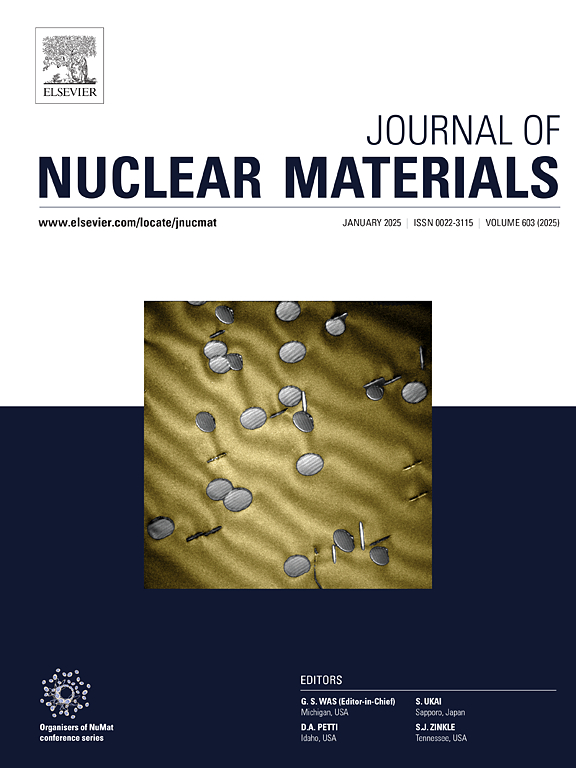AGR-3/4桩内银释放预测与辐照后检测测量的评价
IF 3.2
2区 工程技术
Q3 MATERIALS SCIENCE, MULTIDISCIPLINARY
引用次数: 0
摘要
在使用三结构同位素(TRISO)燃料颗粒的高温气冷反应堆中,准确预测放射性核素输运的燃料性能建模代码是反应堆安全分析的一个重要方面。先进气体反应堆(AGR)-3/4实验的一个目的是评估裂变产物通过燃料颗粒的传输及其随后释放到致密基质和结构石墨材料中的情况。这是通过照射碳化铀氧(UCO)驱动燃料颗粒和设计失效(DTF)颗粒来实现的,这些颗粒作为裂变产物的已知来源。当涉及到这种传输时,特别感兴趣的裂变产物是银(Ag-110 m),因为它具有250天的半衰期,并且在TRISO涂层中具有相对较高的迁移率。为了评估目前燃料性能代码PARFUME和BISON中使用的建模能力和扩散参数,将两个代码预测的银释放分数与AGR-3/4实验的辐照后检查测量结果进行了比较。本文章由计算机程序翻译,如有差异,请以英文原文为准。
Evaluation of AGR-3/4 In-pile Silver Release Predictions Against Post-Irradiation Examination Measurements
Fuel performance modeling codes that accurately predict the transport of radionuclides in high-temperature gas-cooled reactors that utilize tristructural isotopic (TRISO) fuel particles are an important aspect of reactor safety analyses. One objective of the Advanced Gas Reactor (AGR)-3/4 experiment was to assess the transport of fission products through fuel particles and their subsequent release into the compact matrix and structural graphite materials. This was accomplished by irradiating uranium oxycarbide (UCO) driver fuel particles and designed-to-fail (DTF) particles to serve as known sources of fission products. The fission product of particular interest when it comes to such transport is silver (Ag-110 m), as it has a 250-day half-life and has relatively high mobility in the TRISO coating layers. To assess the current modeling capabilities and diffusion parameters employed in the fuel performance codes PARFUME and BISON, the fractional release of silver release predicted by the two codes were compared against post-irradiation examination measurements from the AGR-3/4 experiment.
求助全文
通过发布文献求助,成功后即可免费获取论文全文。
去求助
来源期刊

Journal of Nuclear Materials
工程技术-材料科学:综合
CiteScore
5.70
自引率
25.80%
发文量
601
审稿时长
63 days
期刊介绍:
The Journal of Nuclear Materials publishes high quality papers in materials research for nuclear applications, primarily fission reactors, fusion reactors, and similar environments including radiation areas of charged particle accelerators. Both original research and critical review papers covering experimental, theoretical, and computational aspects of either fundamental or applied nature are welcome.
The breadth of the field is such that a wide range of processes and properties in the field of materials science and engineering is of interest to the readership, spanning atom-scale processes, microstructures, thermodynamics, mechanical properties, physical properties, and corrosion, for example.
Topics covered by JNM
Fission reactor materials, including fuels, cladding, core structures, pressure vessels, coolant interactions with materials, moderator and control components, fission product behavior.
Materials aspects of the entire fuel cycle.
Materials aspects of the actinides and their compounds.
Performance of nuclear waste materials; materials aspects of the immobilization of wastes.
Fusion reactor materials, including first walls, blankets, insulators and magnets.
Neutron and charged particle radiation effects in materials, including defects, transmutations, microstructures, phase changes and macroscopic properties.
Interaction of plasmas, ion beams, electron beams and electromagnetic radiation with materials relevant to nuclear systems.
 求助内容:
求助内容: 应助结果提醒方式:
应助结果提醒方式:


